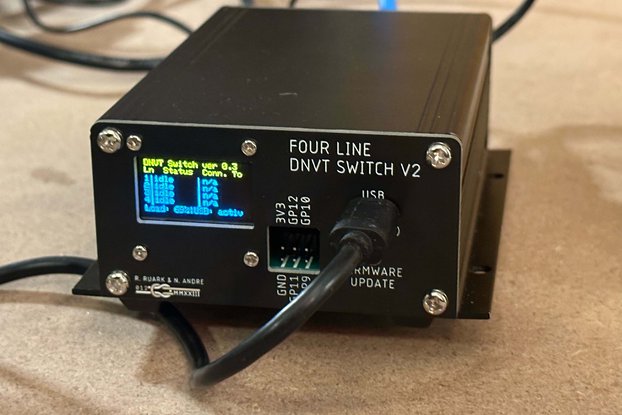Individually switch between multiple Commodore IEC disk drives and printers. Use up to 3 devices on 2 computers.
Designed by CommodoreSam in United States of America
Buy with confidence.
Our Tindie Guarantee protects your purchase from fraud. Learn More
IEC SWITCH Includes switch only. Disk drives shown for scale. Specifications Front - 5 Independent locking push buttons Back - 5 IEC Ports (6 pin din): Case - High Quality Print in PLA. As with all …
Read More…IEC SWITCH
Includes switch only. Disk drives shown for scale.
Specifications
Short description of operation:
Think of each button as a separate A/B switch, but where all A’s are connected and all B’s are connected. Mix and match drives, printers, and computers (limit two computers powered on at a time).
Detailed description of operation:
Each button on the front corresponds to the port behind it switching it to the A or B position. This could also be stated as in or out position. For our purposes in this document, A=”in” and B=”out”.
All six lines of the din port are switched between the A and B positions. When two or more ports are switched to the same position, A or B (in or out), they are connected in a single data bus. All A’s are connected and All B’s are connected. Meaning it is as if they were directly connected via serial cables. Different positions or data buses are never cross-connected (unless you have wired it up incorrectly, i.e. have a cable looped back between ports). Normally, A’s are always disconnected from B’s.
Keep in mind that on each port, you could have more than one device daisy chained on that port. In this case the switch would switch the that whole chain to A or B.
All the ports’ shield grounds are connected regardless of switch position.
Note: The switch is only controlling what devices (disk drives, printers, computers, etc.) are wired together/connected to a data bus. The device numbers that Commodore’s use to communicate on a bus to a specific device still function/remain the same.
Benefits
Cable lengths are shortened compared to daisy chaining. This reduces a lot of loading problems/data errors/bus lockups. Daisy chaining many drives together can cause signal degradation which causes communication errors on the data bus due to the long chain between the computer and the last device in the chain. For example, if you have 4 disk drives and a printer and are running 6 ft. cables between them, that’s 24 ft. of cable between the computer and the printer. With a switch, it’s only 12 ft. However, it’s always a good idea to use shorter cables if possible. You can purchase 1 ft. or 3 ft cables instead of 6 ft.
You can have multiple drives with the same number (like two 8’s) as long as they are not on the same position (A or B). Multiple devices with the same device number cannot be on the same data bus. But for example, you can have a drive 8 on A and another drive 8 on B.
You can have two computers connected and switch drives between them. Again as long as the computers are not on the same bus position (A or B). If two computers are on the same data bus, they will lock up the data bus.
Use Cases:
Two computers can share a full set of drives switching each drive to either bus A or B. Each computer and drive that’s on the same bus (A or B) works together and can be changed at the push of a button.
One computer with multiple drives with the same drive number. When computer and drive are on the same bus (like A position), they communicate. When the drive is in B position, it is disconnected from the computer on A. Quickly reconfigure drive combinations based on hardware or software needs. For example, you can have an SD2IEC drive 8 and a pi1541 as drive 8 (not on the same bus A or B). If the software requires a “real cycle exact 1541” you can switch to the pi1541 to load that. But if the software works great and fast on a SD2IEC drive, then switch to that.
Switches can be daisy chained for additional setups. You can have a switch for drives 8-11 where they are all on the same bus, but have another switch plugged in to port 4. The second switch can be switching between 3 drive 8’s like a real 1541, pi1541, and a SD2IEC.
Things that won’t work or not completely supported.
As stated before, you can’t have two computers on the same bus.
As stated before, you can’t have two drives with the same device number on the same bus.
Certain devices cannot be switched if they are connected via parallel. RAMLinks and CMD HD are good a good example. A CMD HD can be switch, if only connected via serial IEC. But if the parallel cable is connected to the RAMLink, it will not communication over the serial line. This switch only works with the normal Commodore serial connections over the IEC port.
Hot switching or switching while the devices are powered on is not a supported use case. While not supported, I as a user of this product, have not seen any damage or permanent effects of switching devices while the machines are on. But, as I have not encountered every software or hardware configuration, I cannot condone this use case as being 100% safe and take no responsibility for any damage that may occur while using this switch. Switching devices while devices are powered, is like plugging and unplugging IEC serial cables while the machine is on. The low voltages shouldn’t cause any damage but that cannot be guaranteed. Further, certain software and ROMS, like JiffyDOS, determine the available drives and drive types at boot and switching while in use may require software or hardware resets to recognize the new configuration. Again, as a user, I have had success switching between same device numbers that emulate one another like switching between a SD2IEC assigned as device 8 and a 1541 drive assigned as device 8.
If you are looking for a smaller switch with true retro homebrew feel, my friend has what you maybe be looking for… https://www.tindie.com/products/acutisdata/commodore-acutis-data-iec-switcher/
No country selected, please select your country to see shipping options.
No rates are available for shipping to .
Enter your email address if you'd like to be notified when IEC Disk Drive Switch for Commodore 64/128/VIC20 can be shipped to you:
Thanks! We'll let you know when the seller adds shipping rates for your country.
| Shipping Rate | Tracked | Ships From | First Item | Additional Items |
|---|---|---|---|---|
|
:
|
Buy with confidence.
Our Tindie Guarantee protects your purchase from fraud. Learn More

$235.00
Free Shipping!

$19.99
Free Shipping!

$42.88
Free Shipping!

$5.00
Free Shipping!
By clicking Register, you confirm that you accept our Terms & Conditions
We recognize our top users by making them a Tindarian. Tindarians have access to secret & unreleased features.
We look for the most active & best members of the Tindie community, and invite them to join. There isn't a selection process or form to fill out. The only way to become a Tindarian is by being a nice & active member of the Tindie community!
